There is no shortage of Black History and cultural experiences to be found in Raleigh, North Carolina.
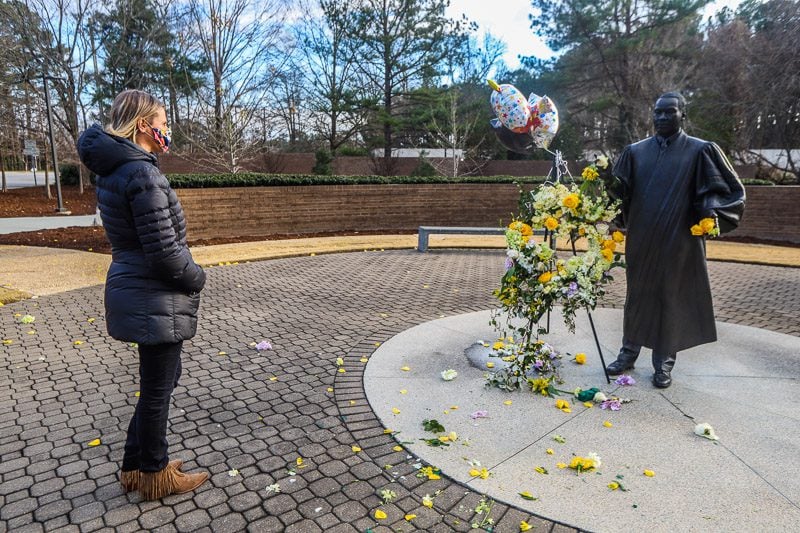
While Raleigh has a lot of African American experiences year-round (and we recommend you connect to them), Black History month provides the perfect inspiration to dive deeper to learn about, recognize, and honor the contributions of the cultural significance of Black Americans in Raleigh (and beyond).
Our region has several excellent museums, monuments, and cultural centers with educational exhibits on the African American experience in the United States.
You can also find great Black American art, music and food throughout the Triangle that helps tell a more vibrant and inclusive Raleigh story and identity.
I was fascinated by doing the research for this post, and I am very inspired to visit these attractions and experiences below. Follow along on our Instagram as we plan to share each one when we do! As always, we’d love to hear your experiences and suggestions in the comments down below.
- What is Black History Month?
- Black History Month Theme for 2024
- Black History Events for 2024
- Black Historical Places in Raleigh
- US Civil Rights Trail in North Carolina
- Other Raleigh Attractions that tell the Black American Story
- Oberlin Village Tour
- Murals in Raleigh Celebrating Black Americans
- Black Owned Businesses in Raleigh
- Black History in Durham
What is Black History Month?
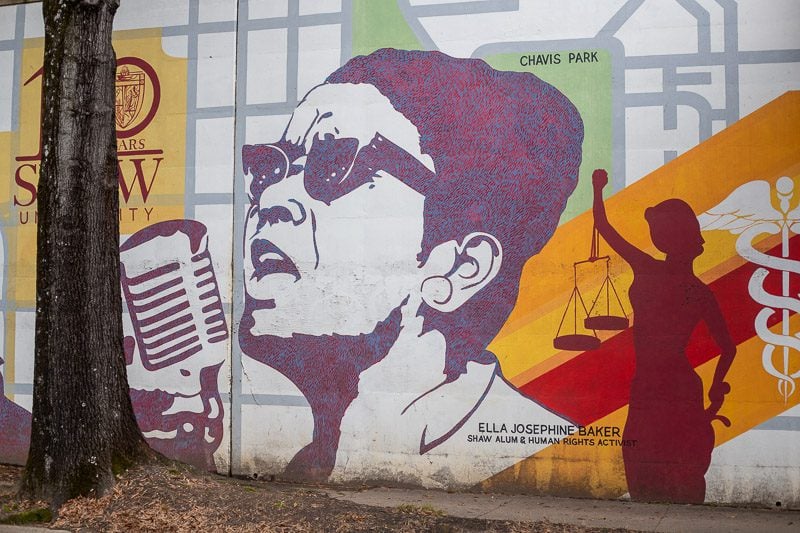
Black History Month is an annual celebration to recognize and honor the achievements by African-Americans and their central role in U.S. history.
Black History Month began in 1926 as “Negro History Week,” a phrase coined by renowned African American historian and scholar Carter G. Woodson. The initiative started to help educate young African Americans about their own heritage and the achievements of their ancestors.
He chose February because the month contained the birthdays of both Abraham Lincoln and Frederick Douglass, two prominent men whose historic achievements African Americans already celebrated.
In 1976, President Gerald Ford officially recognized Black History Month, and it has been recognized every year since by each presiding President who endorses a particular theme.
Other countries around the world, including Canada and the United Kingdom, also devote a month to celebrating Black history. I wish our own country, Australia, did the same!
Click here For Black History Month specific events for 2022 in our February Events Calendar.
Black History Month Theme for 2024
This year the theme for Black History Month is Divine Hands: An Exploration of Black Spirituality, Healing, and the Arts.
Artistic and cultural revolutions, including the New Negro, Black Arts, Black Renaissance, hip-hop, and Afrofuturism, have been spearheaded by individuals of African descent, shaping global trends. 2024’s theme delves into the diverse history and experiences of African American arts and craftspeople.
It’s a call to everyone to study the history of Black Americans’ responses to establish safe spaces, where Black life can be sustained, fortified, and respected.
Black History Events for 2024
Here is a curated list of particular events happening this month in February to honor and celebrate Black History Month. Keep reading for black historical places in Raleigh and other things to do to learn more about Black Americans in Raleigh both past and present. Follow our What’s happening this week in Raleigh post as we’ll share Black History month events each week there too.
- NC MLK Black History Month Parade, Feb 3, 2024, 12pm on Fayetteville St.
- Living in Color art Exhibition Feb 3- 26, 2024 at Dorothea Dix Chapel: A month-long display of visual art representing the experience of people of color living in the south with pieces from pieces by professional and student artists. The opening reception that will include drinks and light hors d’oeuvres, spoken word feature performance, a powerful 15-minute live stage play scene, and music.
- The 90 min Raleigh African American History walking tour highlights the real story behind the African American influences on downtown Raleigh.
- NCMA will screen Black American Movies throughout the month of Feb, including a Raisin in the Sun (Feb 7), The Gospel According to André (Feb 17), and Invisible Beauty (Feb 24).
- Join the African American Cultural Center and Multicultural Student Affairs for Black Transfigurations. Multimedia artist and engineer Mikael Owunna will present works from his artistic practice that transfigure Black bodies into vessels of eternal life.feb 8, 1:30-3pm
- Learn more about African American heritage in Raleigh with the Black History trolley tour that will travel to Oberlin Village. Feb 24 & 25, 2024 1pm and 2:30pm $12
- Lift Every Voice: Black History Month Community Sing a Long, Feb 24, 2024, at the NC Museum of Art. 5pm $8-10
- Throughout the month of February, the Town of Cary will host various events to Celebrate Black American contributions to the arts in Town of Cary. There’ll be jazz ensembles, panel discussions, a cultural cuisine experience, poetry performances, art exhibitions, and black history films See all events here.
Black Historical Places in Raleigh
There are several important historical landmarks in and around Raleigh connected to Black American history.
St Agnes Hospital
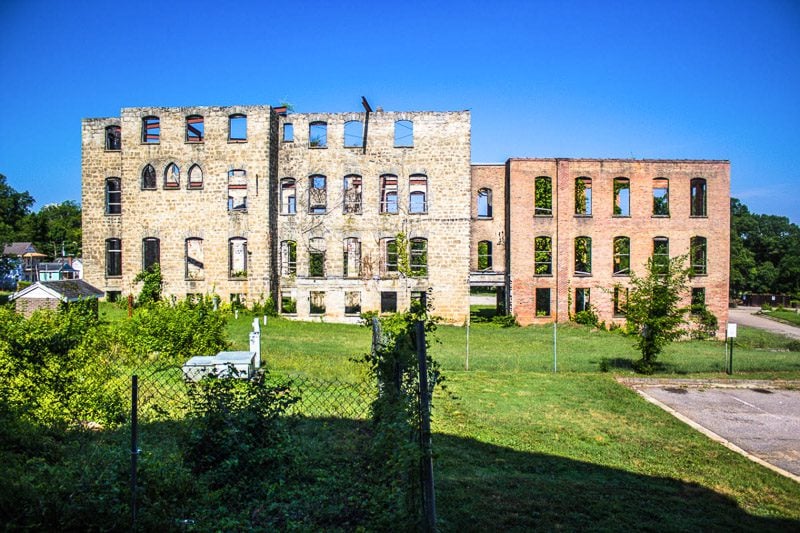
- Address: 1315 Oakwood Avenue (Saint Augustine’s College Campus)
The Saint Agnes Hospital is located on St. Augustine’s College campus near Oakwood Cemetery in the Oakwood Historic District.
St Agnes Hospital provided medical care to the African American Community for 65 years (1896-1961) as well as a training center for nurses. It was known as “The Healing Place,” and in 1922, was referred to as the only well-equipped hospital for Negroes between Washington D.C. and New Orleans, serving not only North Carolina but the adjacent states of Virginia and South Carolina.
The first black heavyweight champion of the world, Jack Johnson, died at St. Agnes Hospital because they lacked the technology that could have saved his life.
You’ve probably passed by this crumbling 4-story shell of a building many times wondering what stories once lay within. Now you know how important they were.
St. Agnes Hospital was declared a Raleigh Historic Landmark in 1979.
The Envision Saint Agnes Hospital Project (sponsored by VAE Raleigh) has a plan and mission for university students to create art installations at the site that illustrate the importance of the Hospital to Saint Augustine’s and the surrounding community.
I love the view of it from Oakwood Cemetery. When we visited, we heard music coming from that direction and I thought it was from inside it. I thought to myself, how cool would that building be as an outdoor music venue!
Let’s hope some exciting plans are in place for its future as it’s a fascinating chapter of Raleigh’s story.
Saint Augustine’s University
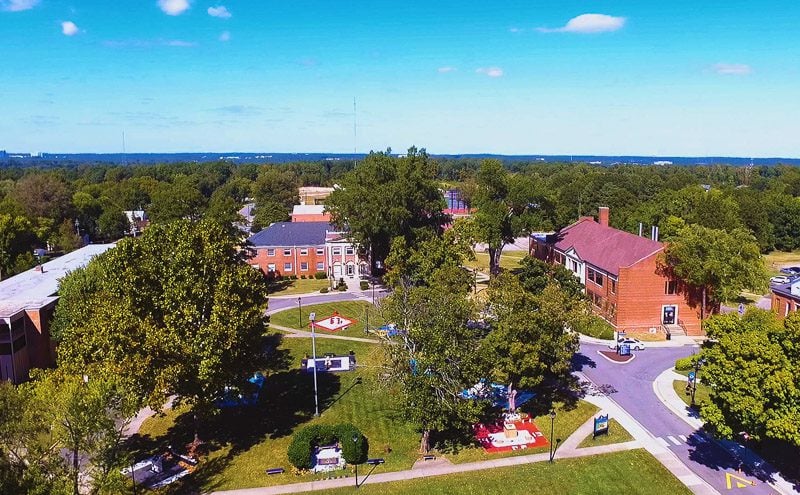
- Address: 1315 Oakwood Ave, Raleigh, NC 27610
Saint Augustine’s University was chartered as Saint Augustine Normal School and Collegiate in 1867 for the education of freed slaves by the Episcopal clergy.
It was responsible for establishing St. Agnes Hospital and Training School for Nurses, the first nursing school in the state of North Carolina for African American students.
The university later became the nation’s first historically black university to own an on-campus commercial radio station and television station. Today, Saint Augustine enrolls an average of 1,000 students in more than 20-degree programs.
One of the oldest buildings now on the campus is a Norman Gothic-style chapel built in 1895.
The irregular granite T-Shaped chapel was constructed by students under the direction of Rt. Rev. Henry Beard Delany (1858-1928), who later became the first African American elected bishop in the Episcopal Church in N.C.
Pope House Museum
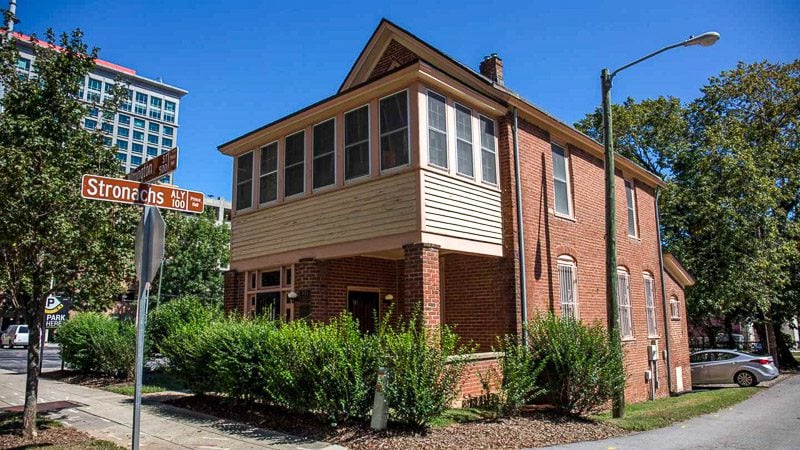
- Address: 511 S Wilmington St, Raleigh, NC 27601
- Admission: Free
- Open Sat: 9 a.m. to 4 p.m.; Sun: 1 to 4 p.m.
- Tours are first come, first served. Please call 919-996-2220 for more information
Built in 1901, The Pope House was home to Dr Manassa Thomas Pope and his family. It is the only African American house museum in the state of North Carolina and was listed on the National Register of Historic Places on November 22, 1999.
The Pope House Museum offers a glimpse into the life of Dr Pope, a prominent physician and the only African American man to run for mayor of a Southern capital in the midst of the Jim Crow Era.
Pope was in the first graduating class of Shaw University’s Leonard School of Medicine in 1886 and among the first Black American physicians licensed to practice in North Carolina.
He founded the Old North State Medical Society in 1887 with three medical school classmates in response to being barred from joining the all-white North Carolina medical society. The society has played an important role in improving the health and health care for the Black Americans in North Carolina.
The house features original furnishings to the family and many historical artifacts giving insight into a remarkable man and family.
In celebration of Black History Month, the Pope House Museum will provide scheduled weekday tours of 15 or fewer. Learn about Dr Manassa T. Pope; his medical practice; his family; his contributions to the African American community in downtown Raleigh; and explore one of the oldest standing houses on Wilmington Street.
Tuesday – Friday in Feb., 10:00 a.m. and 2:00 p.m. Cost: Free (suggested $5 donation)
Black Main Street, Raleigh
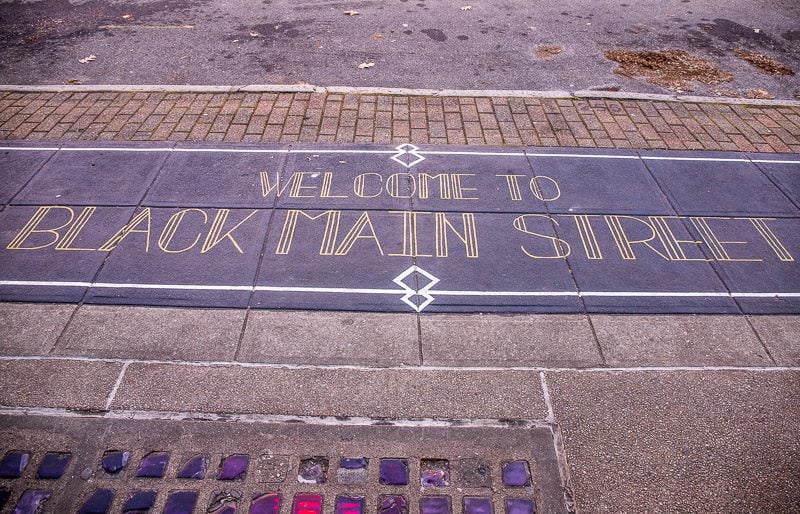
- Address: East Hargett St between Fayetteville St and Blount St
I only recently learned that Hargett Street in Downtown Raleigh (where we love to drink, eat and play) was once the segregated business district and cultural hub for the Black community in Raleigh.
At its height, Black Main Street was home to 50+ Black-owned businesses namely medical offices, law offices, a hotel, restaurants, barbershops, and retailers.
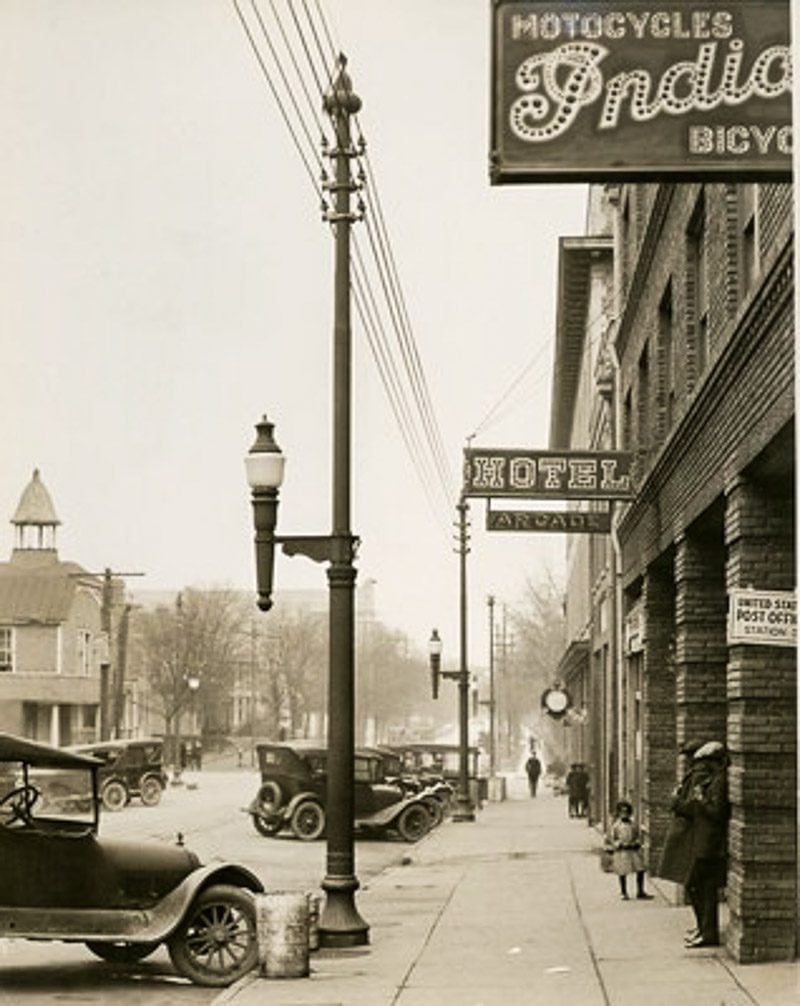
Artist TJ Mundy recently created a series of murals on the footpath marking four buildings that played a major role on Black Main Street.
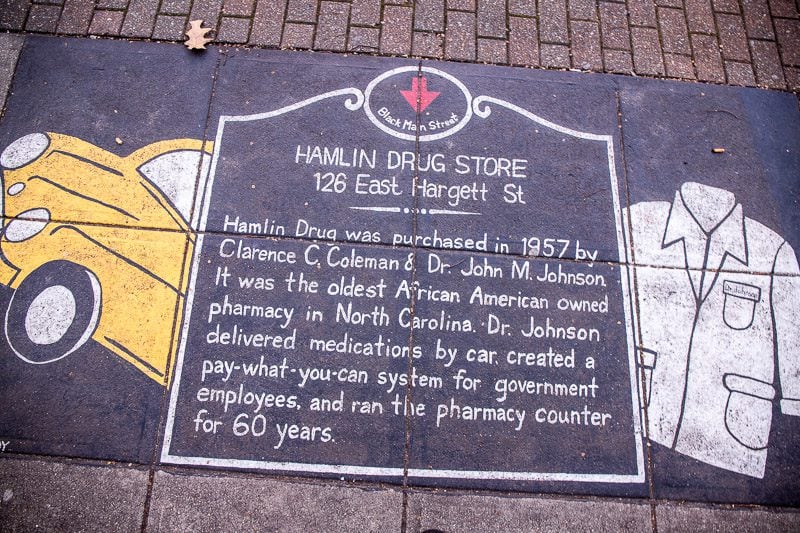
The Delany-Evans building, built by Dr. Lemul T. Delany, who was the first Black surgeon practicing at St Agnes Hospital, housed Raleigh’s second Black dentist and later, the first Black public library in Wake County.
Where the GoRaleigh station now stands used to be the cultural and social hub for Raleigh’s Black community, and the Hamlin Drug Store served downtown Raleigh for over a century and was the oldest Black-owned pharmacy in the entire state.
John Chavis Memorial Park
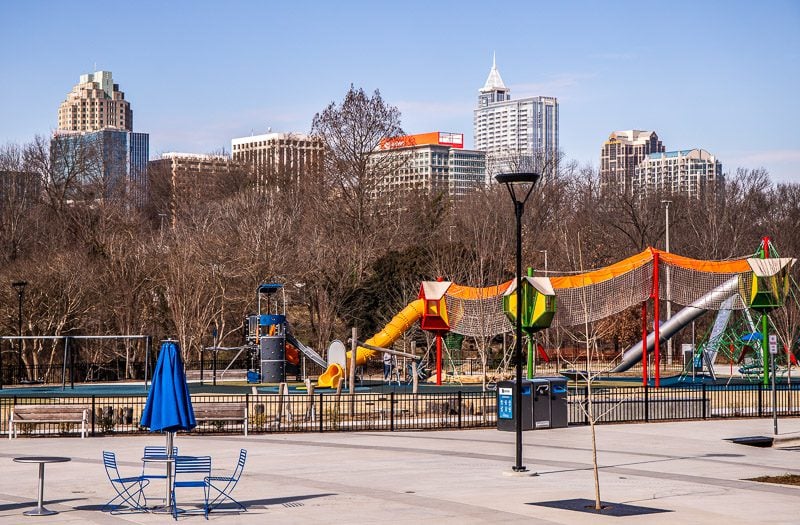
- Address: 505 Martin Luther King Jr. Blvd., Raleigh, NC 27601
The John Chavis Memorial Park was opened in 1937 as a recreational facility for the African American residents of the city. Raleigh’s city council no longer wanted Black residents visiting the existing Pullen Park and mixing with Raleigh’s white residents.
It was named after John Chavis, a free Black man who fought in the Revolutionary War. As a teacher and activist, he opened schools for both black and white children throughout Wake and Orange counties.
This 37-acre park was a vibrant place to Black Americans to come together and enjoy its facilities, including a swimming pool and famous 1923 carousel (which you can still ride today).
In April 2016, John Chavis Memorial Park was added to the National Park Service’s National Register of Historic Places.
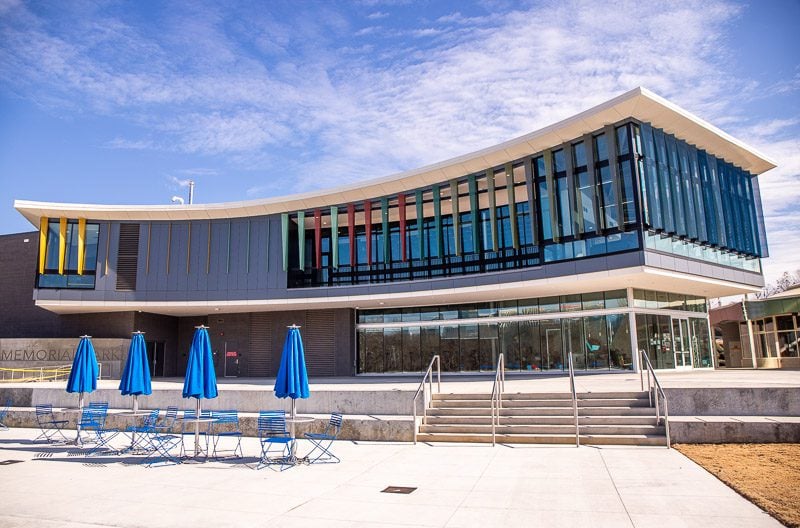
The park has recently undergone a huge renewal project with a new community center, central plaza, and playground (that people rave about), as well as renovations to the original carousel building. The park includes a half-mile section of the Capital Area Greenway Trail.
The John Chavis Memorial Park: Past to Present is an outdoor exhibit interpreting events that impacted the development of the park while highlighting community stories from the park’s earliest days up to the present.
The key message shared is that the park stands as a symbol of African American agency and identity and remains a place of power and civic engagement for the local, regional, and even national Black community.
John Chavis Memorial Park Community Center will offer a variety of programs for Black History Month including family movie nights, Black history movies, and Black inventor’s workshop for kids. See more here.
African American Cultural Center, NC State Campus
The African American Cultural Center promotes awareness of and appreciation for the Black experience through activities and events that enhance academic excellence and strengthen cultural competence for NCSU and its surrounding communities.
They host a series of Signature events every year around special festivals and celebrations and encourage all students, faculty, and staff to participate in. See their Black History Month events here.
Mt Hope and City Cemetery
There are two important historical cemeteries in Raleigh with a Black history.
Mt. Hope Cemetery was founded in 1872 as a city owned African American cemetery. It became Raleigh’s largest Black cemetery and one of the first municipal cemeteries of its kind in North Carolina.
The hilly cemetery is located on 34.5 acres at Fayetteville Street and Prospect Avenue with views of downtown.
City Cemetery is located on 7.68 acres at East and Hargett Streets and New Bern Avenue. It’s the oldest public cemetery in Raleigh and includes the founding fathers of Raleigh, legislators, free and slave African Americans, and stone masons from England and Scotland who helped build the state capitol building.
john Hunter and Spring House, Dorothea Dix Park
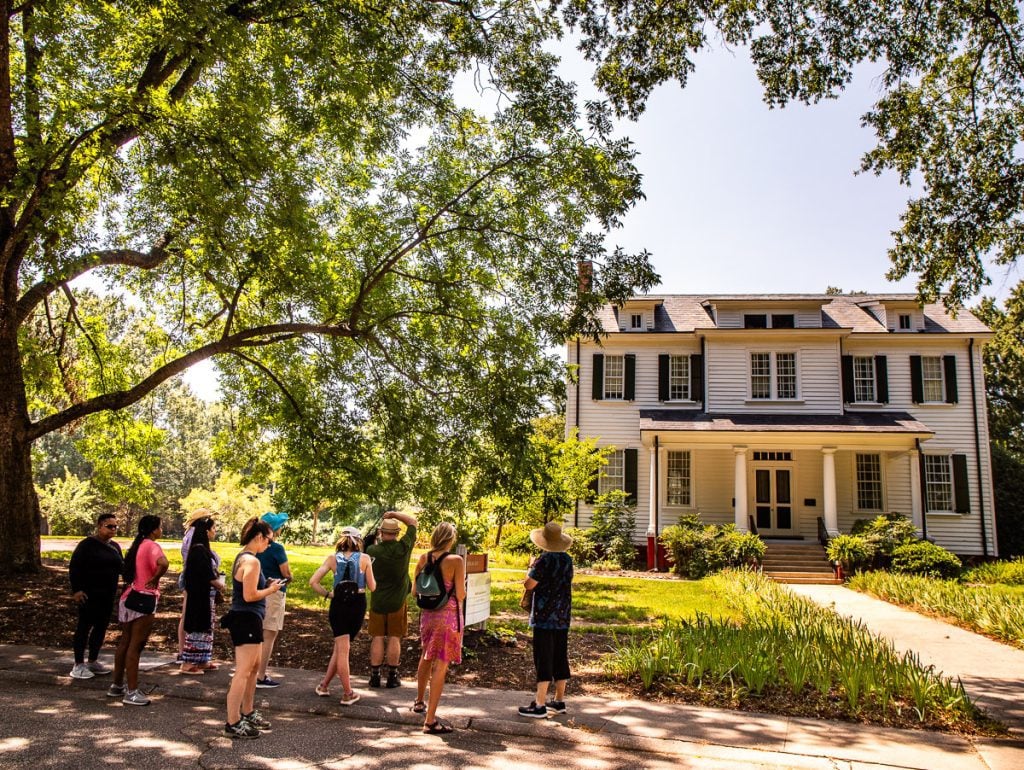
On our fascinating free walking tour of Dorothea Dix Park, we learned interesting history about slave John Hunter and the Spring House, now called the Japan House and owned by NC State.
It is the oldest structure on campus, built sometime between 1816 and 1820 as the 2,500-acre plantation home owned by Theophilus Hunter.
There is an information board out front to tell you the story of the slaves, who without, this plantation would not have been possible, nor the land that was eventually sold off and given back to the people for us to now enjoy.

Theophilus left a unique will that documented all the details of all the slaves. One of those was John Hunter who lived to be 112 and experienced the Revolutionary War, the Civil War and Emancipation.
City historian researchers were able to use that information to help find hundreds of descendants of John Hunter. In 2019 they invited them to come to Dorthea Dix to learn more about their ancestors’ important contributions to the city, state and beyond and to celebrate kinship.
They have regularly kept in touch and are now planning another reunion this year. A portrait of John Hunter can also be seen on the foyer walls of the chapel.
US Civil Rights Trail in North Carolina
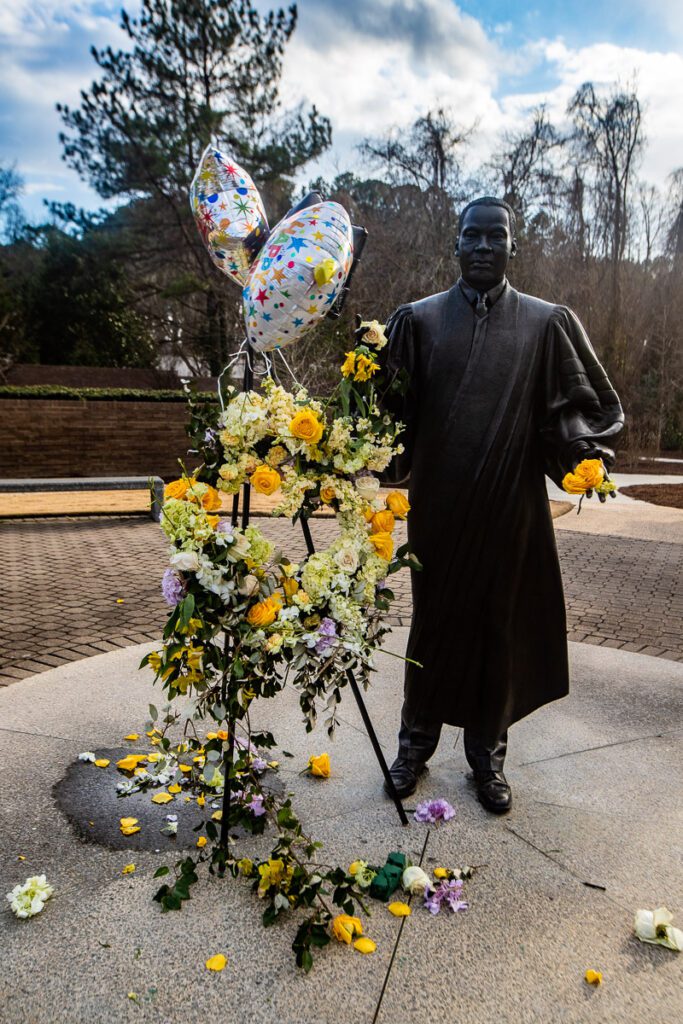
North Carolina played a pivotal role in the U.S. Civil Rights Movement and several places in North Carolina are stops on the Civil Rights Trail.
The U.S. Civil Rights Trail is a collection of over 100 attractions across 14 states and includes churches, courthouses, schools, museums, and other landmarks in the Southern states and beyond. These attractions played a pivotal role in advancing social justice in the 1950s and 1960s, shifting the course of history.
Visiting these sites will help you gain a broader understanding of the Civil Rights Movement. These experiences are either in Raleigh, or an easy drive from Raleigh and would make a great day trip.
Dr. Martin Luther King Jr. Memorial Gardens
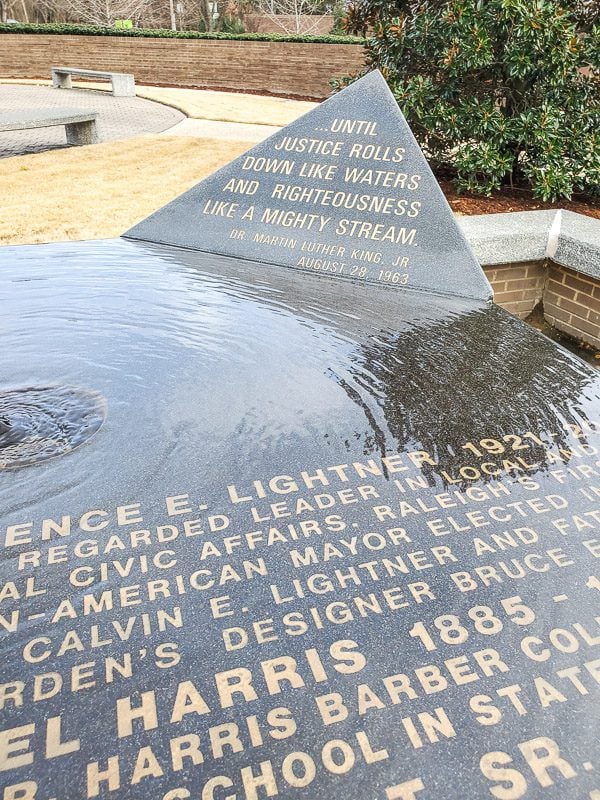
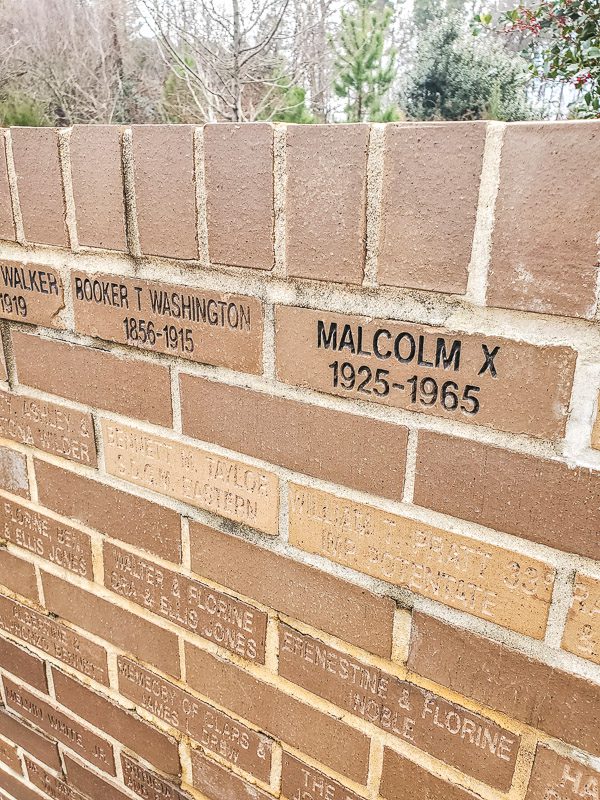
- Location: 1215 Martin Luther King Jr Blvd, Raleigh, NC 27610
In Raleigh, we have the first public park in the nation devoted to the legacy of Dr. Martin Luther King Jr. and his contributions to peace, justice, equality, and human dignity.
Within the gardens are a life-size sculpture of Dr. King, a 12-ton granite water monument honoring the area’s civil rights leaders, and a 2,500-brick walkway recognizing state and national supporters.
Estey Hall + Shaw University
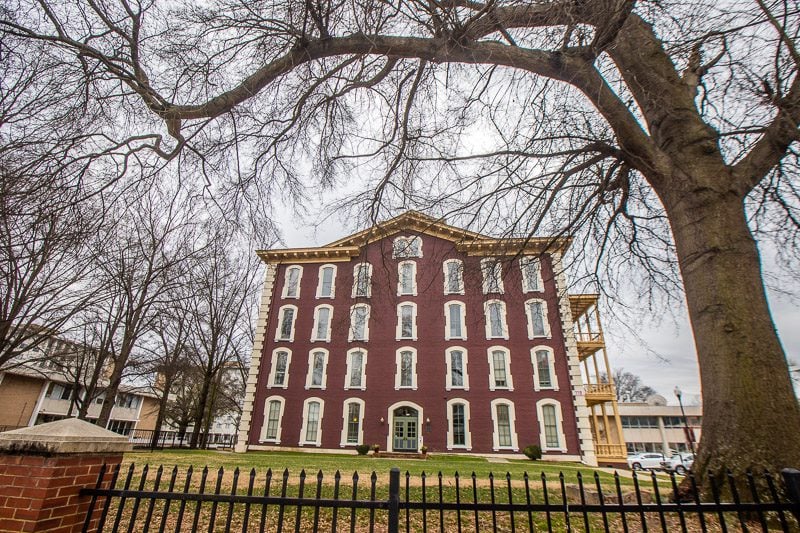
- Address: 721 S. Wilmington St., Shaw University, Raleigh, NC 27601
Founded in 1865, Shaw University is the first historically Black institution of higher education in the South and among the oldest in the nation.
Shaw boasts many “firsts”: the first college in the nation to offer a four-year medical program, the first historically Black college in the nation to open its doors to women, and the first historically Black college in North Carolina to be granted an “A” rating by the State Department of Public Instruction.
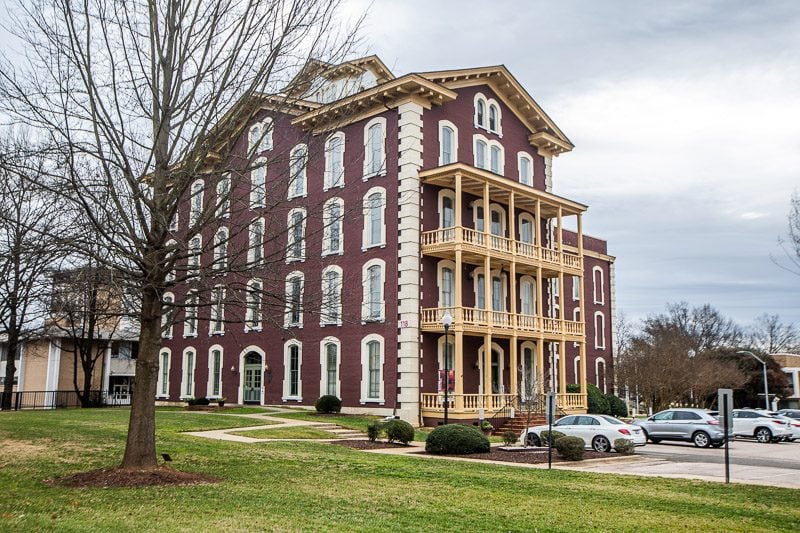
The oldest surviving building of Shaw University, Estey Hall is the first building constructed (1874) for the higher education of black women in the United States and is listed on the National Register of Historic Places.
In 1960, Ella Baker, who had been class valedictorian at Shaw in 1927, was credited for creating the Student Nonviolent Coordinating Committee to help give young Blacks more of a voice in the Civil Rights Movement. That committee would end up creating important initiatives such as Black voter registration drives and the Freedom Rides.
She was a close confidante of Dr. Martin Luther King Jr. and the director of the Southern Christian Leadership Conference.
TIP: A great birds eye view of this gorgeous red brick building can be seen from the 10th and Terrace rooftop bar at the Residence Inn Downtown Raleigh. See our review here.
International Civil Rights Center & Museum, Greensboro
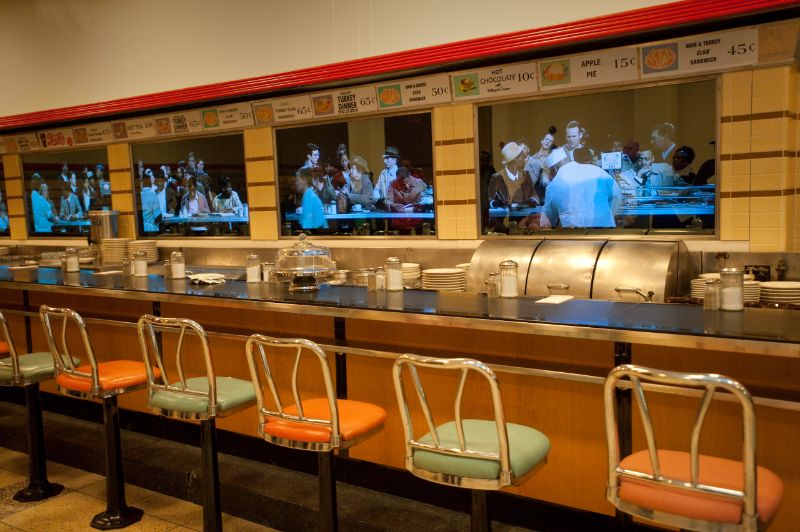
- Address: 134 S Elm St, Greensboro, NC 27401
- Hours: Mon -Sat 10-6pm
- Cost: $15
The International Civil Rights Center & Museum is located in Greensboro NC, in the original (rehabilitated) F.W. Woolworth’s Building.
It honors and tells the story of the four black students from Agricultural & Technical College of North Carolina (now North Carolina A&T State University) who challenged segregationists and set the standard for sit-in movements throughout the state and nation.
The “white only” seats and counter where the four freshmen refused to move from are in the building in their original form. It’s an important stop on the Civil Rights Trail.
Other Civil Right Museums we’ve loved on our travels across the USA.
- The Civil Rights Museum, Memphis
- Mississippi Civil Rights Museum, Jackson
- Civil Rights Memorial Center, Montgomery Alabama ( + 4 other Civil Rights Trail experiences)
- Dr. Benjamin Mays Historic Site in Greenwood, South Carolina
Other Raleigh Attractions that tell the Black American Story
The North Carolina Museum of History
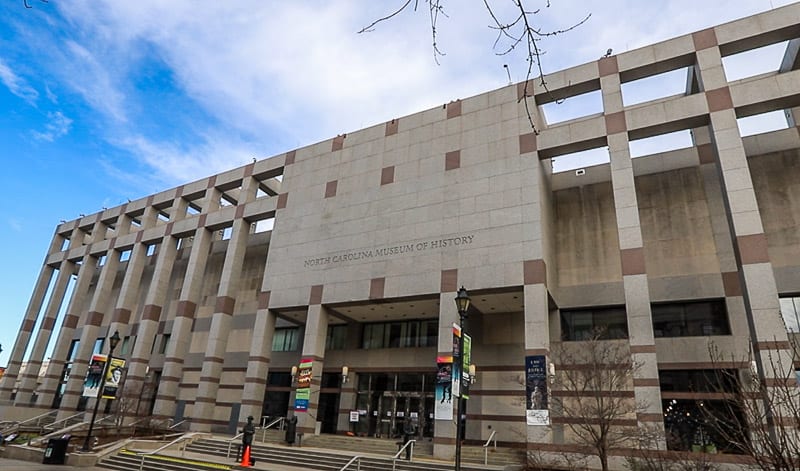
- Address: 46 East Edenton Street, Raleigh, NC 276
- Hours: Monday–Saturday: 9 a.m. – 5 p.m.; Sunday: Noon–5 p.m.
- Admission: Free
The North Carolina Museum of History has exhibits which share the African American story and their contributions to the history of North Carolina.
“The Story of North Carolina” exhibit includes a lunch counter from a 1960 Salisbury, N.C., sit-in during the American civil rights movement and a restored one-room slave cabin from Martin County where seven enslaved African Americans lived in 1860.
Video presentations dive deeper into subjects such as secession, Reconstruction, and the Wilmington Race Riot. The museum also offers a separate gallery for temporary exhibits.
Inside the museum is also the N.C. Sports Hall of Fame, which honors both men and women African American athletes who have made a lasting impact on the state’s rich sports history.
The North Carolina Museum of History offers online videos, educational resources, blogs and podcasts to learn more about Black history. Click here for more.
The City of Raleigh Museum (COR Museum)
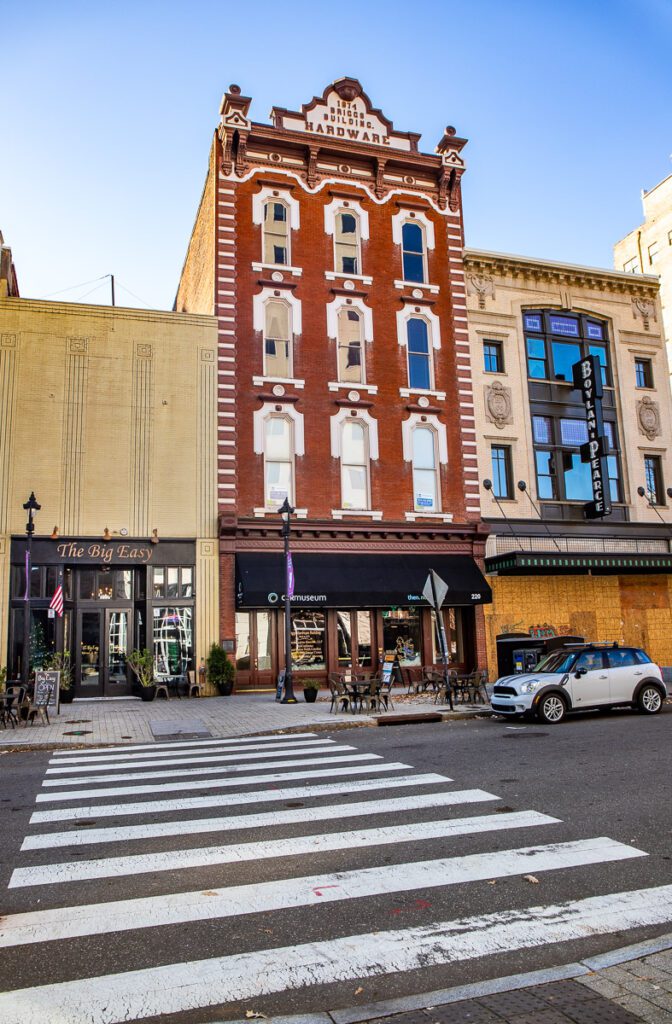
- Address: 220 Fayetteville Street Raleigh, NC 27601
- Hours: Tues-Sat 9am-4pm.; Sun 1-4pm
- Cost: Free
The City of Raleigh Museum is also a great place to learn more about the history and culture of Black Americans in Raleigh, NC. Located in the 1874 historic Briggs Building, a former hardware store, the museum is dedicated to preserving and interpreting the history of North Carolina’s capital city while envisioning its future.
The museum features exhibit on a variety of topics, including African American history, art, and culture.
Let Us March On: Raleigh’s Journey Toward Civil Rights tells the story of Raleigh’s struggles to unite a divided society. The exhibit features a timeline of events and images through more than 5 decades of a movement for equal rights for all.
The North Carolina State Capitol
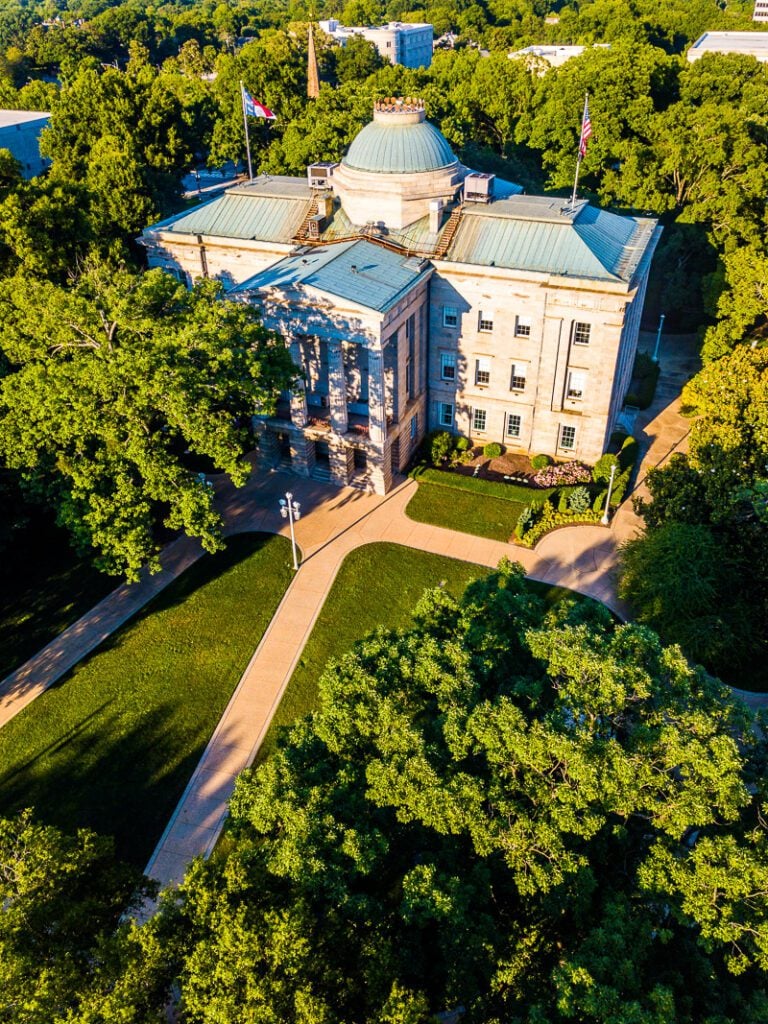
- Location: One East Edenton Street, Raleigh, N.C.
- Hours:
- Monday – Friday 9a.m. – 5p.m.
- Saturday 10a.m. – 5p.m.
- Closed Sunday and most major holidays
- Admission: Free
Built between 1833 and 1840, the North Carolina State Capitol Building is one of the finest surviving examples of Greek Revival civic buildings.
It originally housed the Governor’s Office, Cabinet Office, Legislative Chamber, State Library, and State Geologist’s Office.
Now, it has fascinating exhibits that tell the story of its constructing (including the honest story of its construction by enslaved people) and several notable figures, including Black Americans and Native Americans.
I was impressed to see the effort this National Historical Landmark is making to tell inclusive stories.
Admission is free and open to the public. Tours are mostly self-guided, but guided tours are possible. Click here for more.
The North Carolina Museum of Art
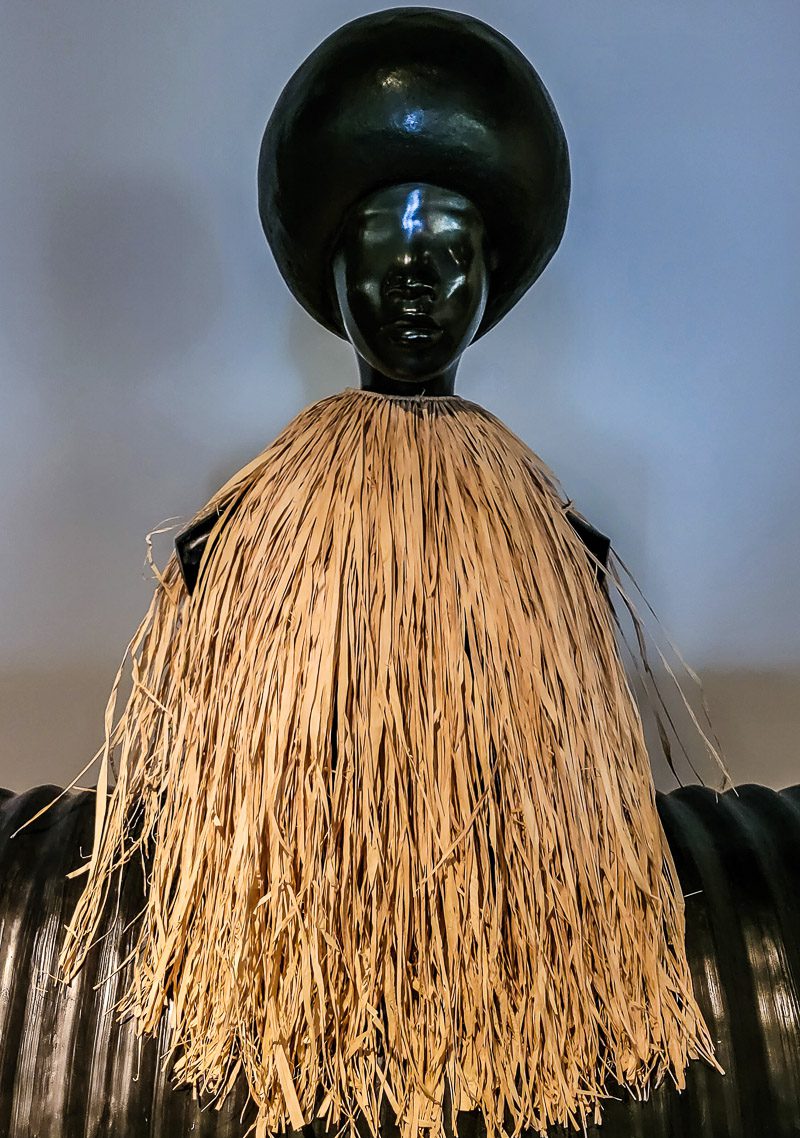
The North Carolina Museum of Art does a fantastic job of highlighting multiple diverse histories, perspective and voices in their collection displays and temporary exhibits. This is just one of the many reasons I think it’s Raleigh’s best attraction.
The North Carolina Museum of Art boasts a permanent collection in their West Building that covers over 5,000 years of art history, ranging from ancient Egypt to contemporary American art. This makes the museum a leading institution for art in the southeastern United States.
IT also has the 164-acre Ann & Jim Goodnight Park with hiking trails, magnificent sculptures (some by Black artists) and an outdoor theater that showcases Black performances and performers.
The annual Art in Bloom festival in March sometimes features Black artists and florists.
BLACK HISTORY MONTH: Lift Every Voice: Black History Month Community Sing A Long, Feb 24, 2024
The NC Art Museum will host a gathering of choirs, ensembles, and community participants from across the state that includes spirituals, ring shouts, and music reflective of the civil rights movement of the 1950s and 1960s as well as Black experience in the US.
Mordecai Historic Park
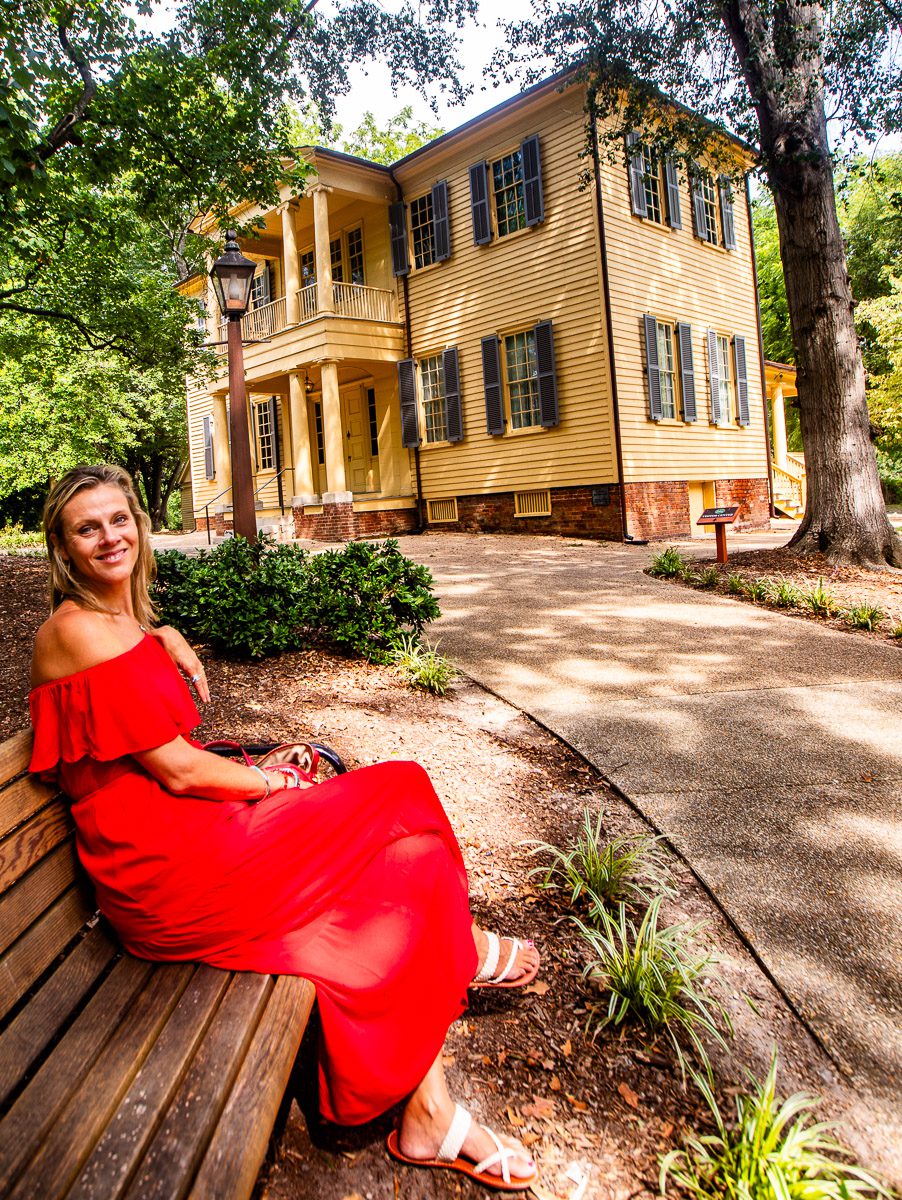
- Address: 1 Mimosa St Raleigh, NC 27604-1203
- Cost: Adults – $7, Senior – $4, Youth – $4. Children 6 and under are free.
The Mordecai Historic Park was once the site of the largest plantation in Wake County. and is home to Mordecai House, the oldest house in Raleigh in its original location ca. 1785 and the Birthplace of Andrew Johnson.
The park also shares the stories of the 200 African American slaves who lived on Mordecai Plantation between the American Revolution and the Civil War.
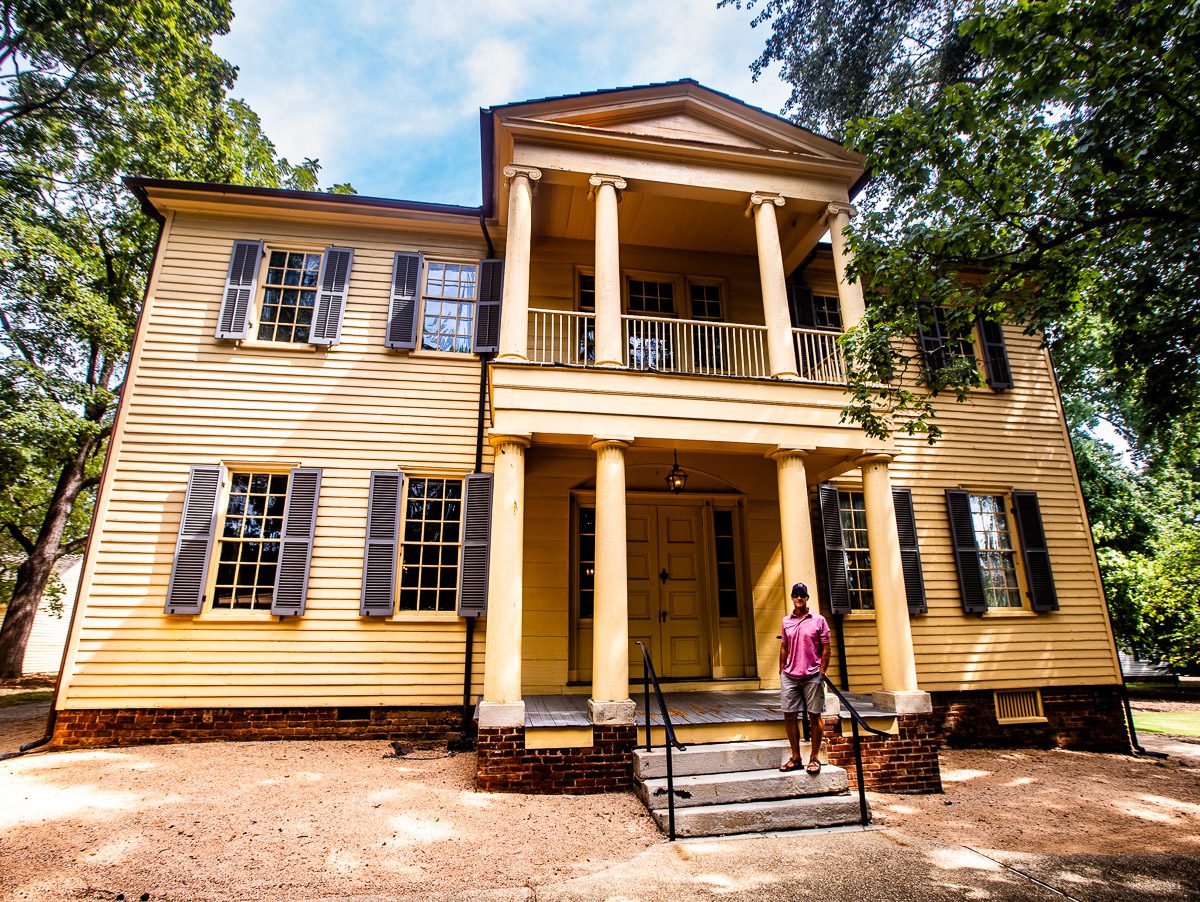
Tours of the Mordecai House and outbuildings are offered at the top of the hour (10am – 3pm) for about 50 mins. You can walk around the grounds for free at any time.
The Mordecai Historic House will run a Black History Trolley Tour on February 24, 2024. Learn more about African American heritage in Raleigh with this historic trolley tour that includes historic homes, schools, churches and businesses important to Raleigh’s African American history.
Oberlin Village Tour
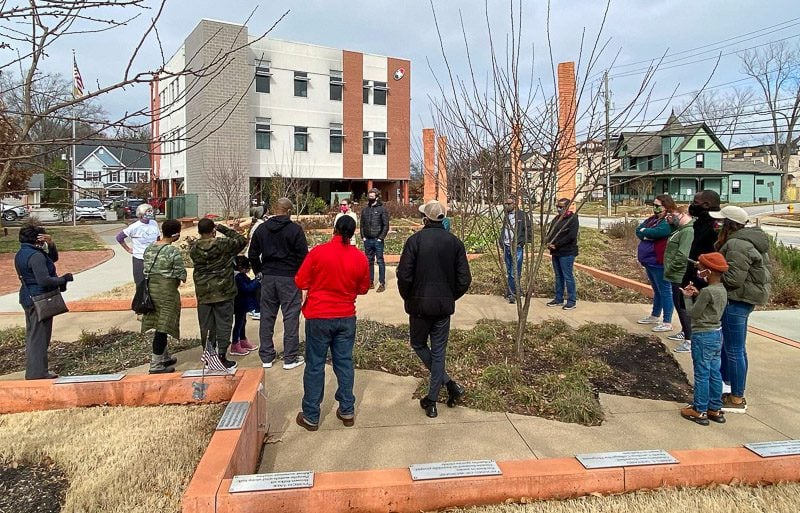
Oberlin, near the Village District on Oberlin Road, originated as a freedman’s village. This antebellum free Black enclave was built by former slaves away from the eyes of white supervisors and grew into an African American municipality.
A self-guided tour of Oberlin village can be accessed through the Raleigh Historic App. It will lead you to historic sites such as the Oberlin Cemetery, the Wilson Temple United Methodist Church and the Plummer T. Hall House.
The Oberlin Heritage Center has a wide variety of guided walks (in warmer months) to help you learn more about this prosperous freedman’s village. Check here to see current schedules.
Murals in Raleigh Celebrating Black Americans
Kendrick Lamar, Drake, J. Cole, and Nicki Minaj
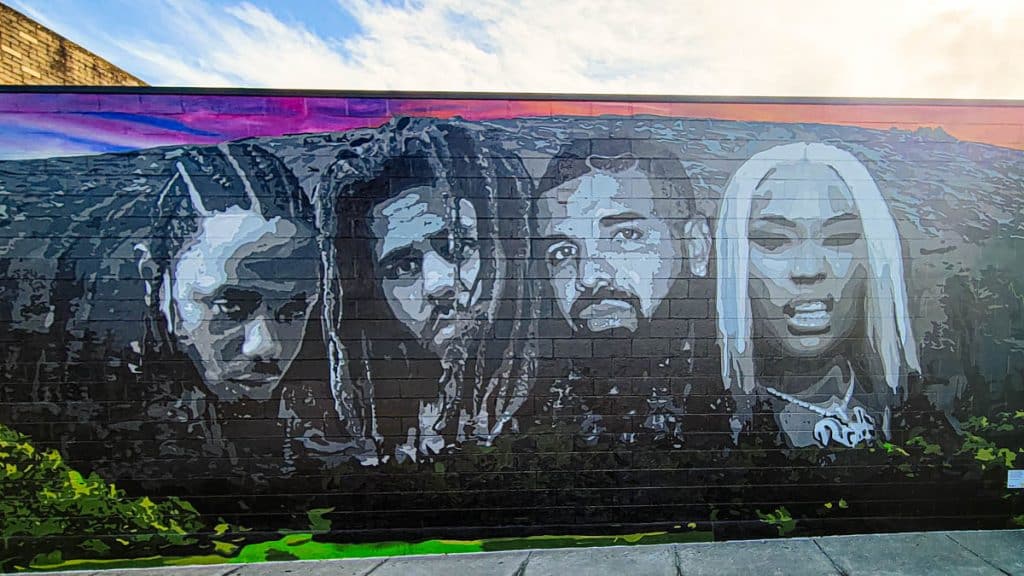
- Address: 412 S. Dawson St., Raleigh 27601 (near Crank Arm)
- Artist: www.jeksone.com
A mural not to miss for Black history month in Raleigh is the Mount Rapmore of Hip Hop featuring North Carolina’s own. J. Cole.
You’ll find this gigantic portraits of artists Drake, Nicki Minaj, Kendrick Lamar in the parking lot beside Crank Arm Brewery in Downtown Raleigh.
Speaking of J Cole, a Raleigh festival not to miss is his Dreamville, held each April at Dorothea Dix Park. Drake and Kendrick Lamar have played before, and rumor has it Nikki Minaj will finally appear in 2024. Read our Dreamville guide here – It’s a stellar Raleigh event!
Go Vote
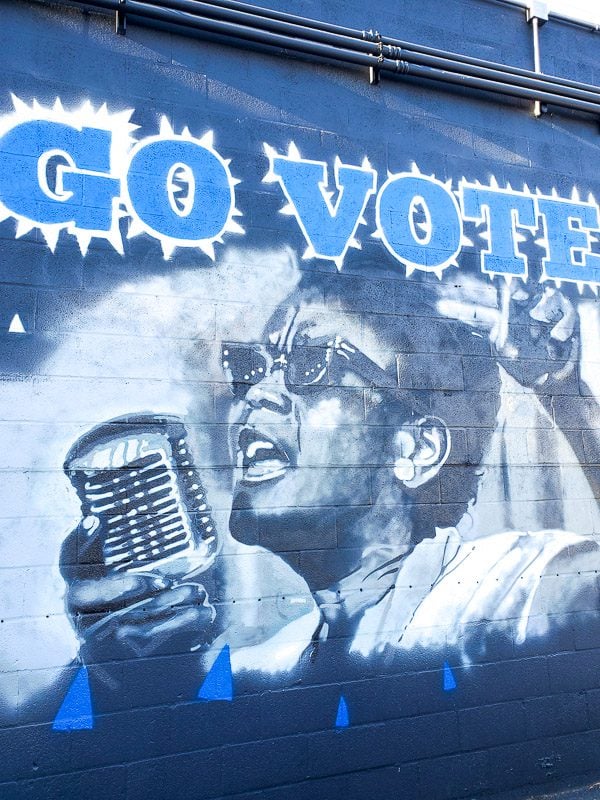
- Address: 827 W Morgan St, Raleigh
- Artist: William Paul Thomas
Behind Trophy Brewing you’ll find this Go Vote mural celebrating Ella Baker and her contributions to encouraging Black voting in the South
John Lewis

- Address: 827 W Morgan St, Raleigh
- Artist: Jalel Ronin
Also behind Trophy Brewing is this awesome mural of the great and late John Lewis, a deeply impactful Civil Rights leader and Congressman.
Morgan Street Jazz Monsters of NC
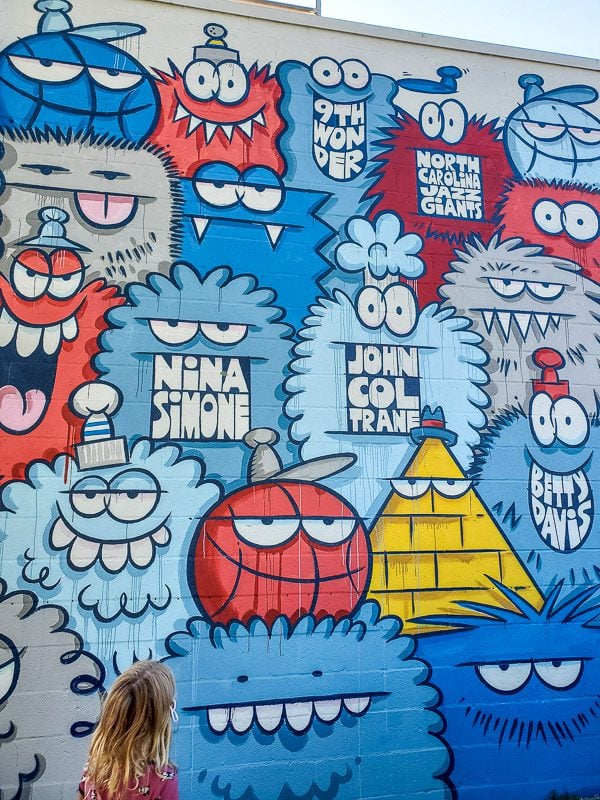
- Address: 827 W Morgan St, Raleigh
- Artist: Kevin Lyons
AGAIN, Trophy Brewing produces an outstanding mural celebrating the contributions of iconic musicians from the Tar Heel State; Nina Simone, J. Cole, Rapsody, Thelonious Monk, 9th Wonder, and more.
Ann and Allen Iverson
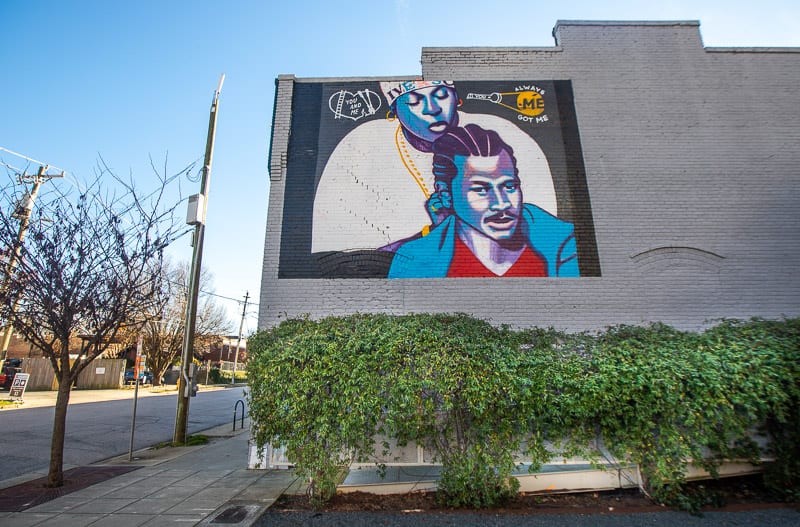
- Address: 409 W Martin St Raleigh, NC 27601 | Warehouse District
- Artist: Steve Powers
Former NBA star Allen Iverson is getting his hair braided court side by his mother Ann during an actual game. Moms always taking care of business!
Shaw University 150th anniversary mural
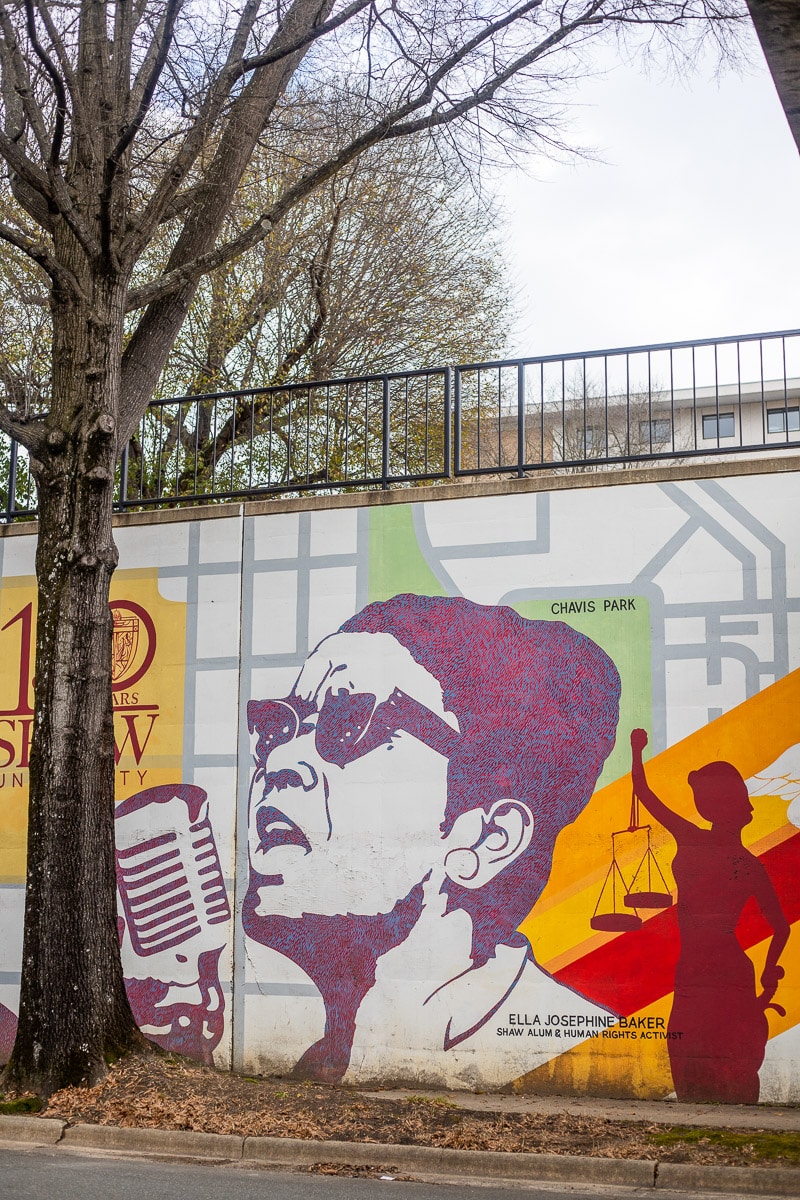
- Address: 720 S. Blount St., Raleigh (behind Estey Hall)
- Artist: Scott Nurkin
This mural celebrating Shaw University’s 150th anniversary showcases three themes of technology, entrepreneurship and sustainability.
Dare to Dissent
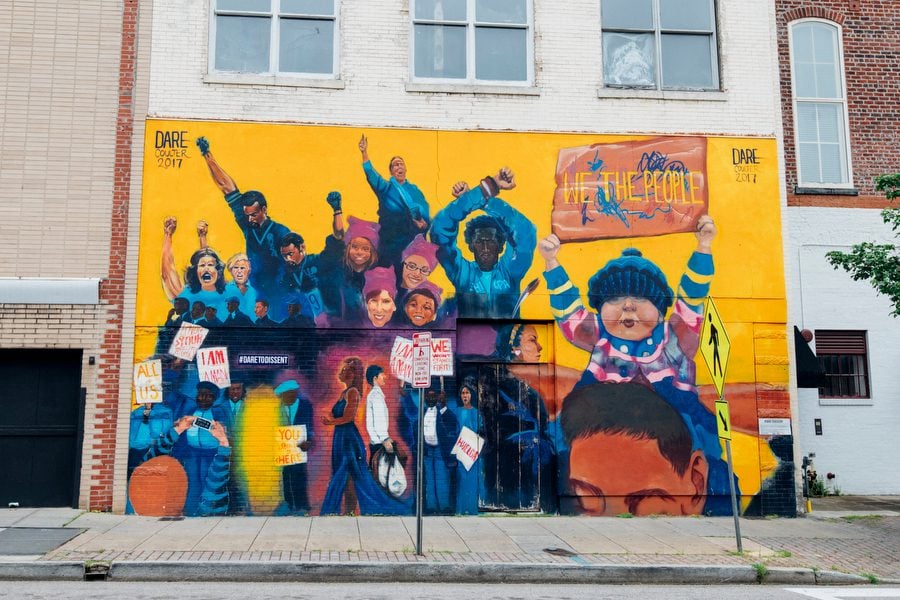
- Address: 214 S Salisbury St Raleigh
- Artist: Dare Coulter
This 32×23 ft. mural pays tribute to the First Amendment and to the courageous individuals who exercised their right to protest throughout history.
It features iconic imagery from some of the most famous protests in history including the 1968 Olympic Black Power Salute by American Olympians Tommie Smith and John Carlos, the 1965 Selma to Montgomery March also known as “Bloody Sunday”, the 1969 Stonewall Riots, and the 1968 Memphis Sanitation Workers’ Strike also known as the “I Am A Man March.”
Leville Moton Mural
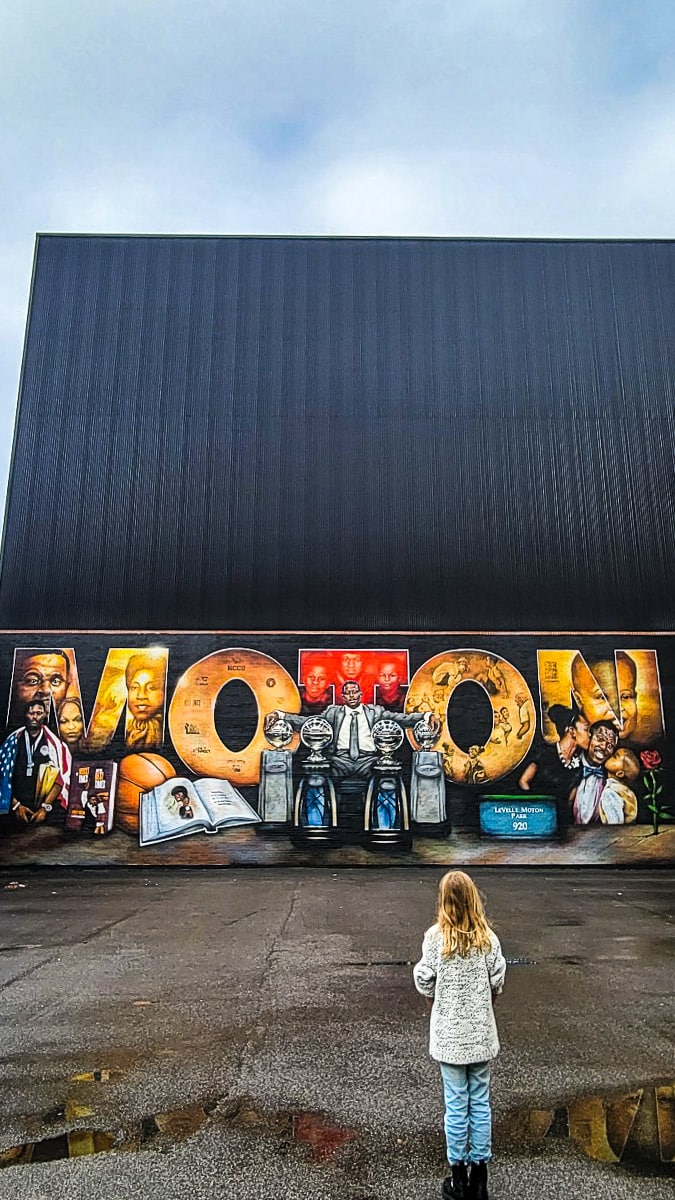
- Address: South Salisbury St (opposite DECO)
- Artist: Sean Kernick
This mural features North Carolina Central University (NCCU) men’s basketball coach, LeVelle Moton, surrounded by championship trophies, family and organizations like the Raleigh Boys and Girls Club that helped shape him.
If you know of any other murals celebrating Black Americans or created by a Black American, please leave them in the comments!
Like Father, Like Son
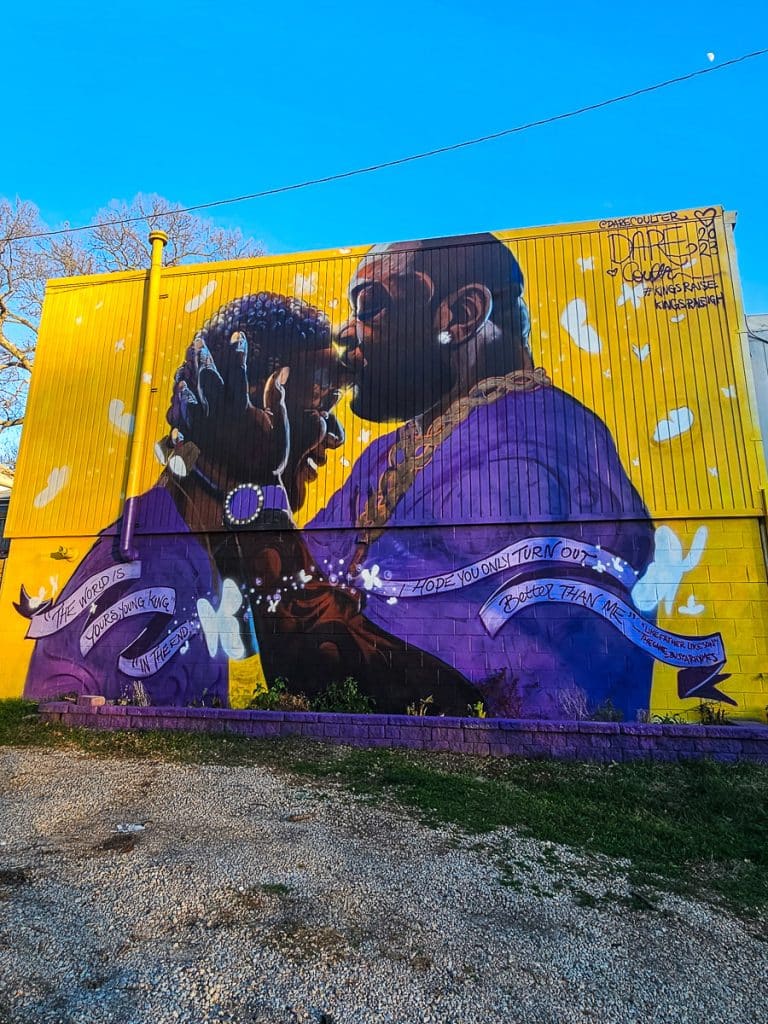
- Address: Tryon Hill Dr (behind Irregardless Cafe)
- Artist: Dare Coulter
“The world is yours, young king. In the end, I hope you only turn out better than me” Like father like son – The Game, Busta Rhymes.
Black Owned Businesses in Raleigh
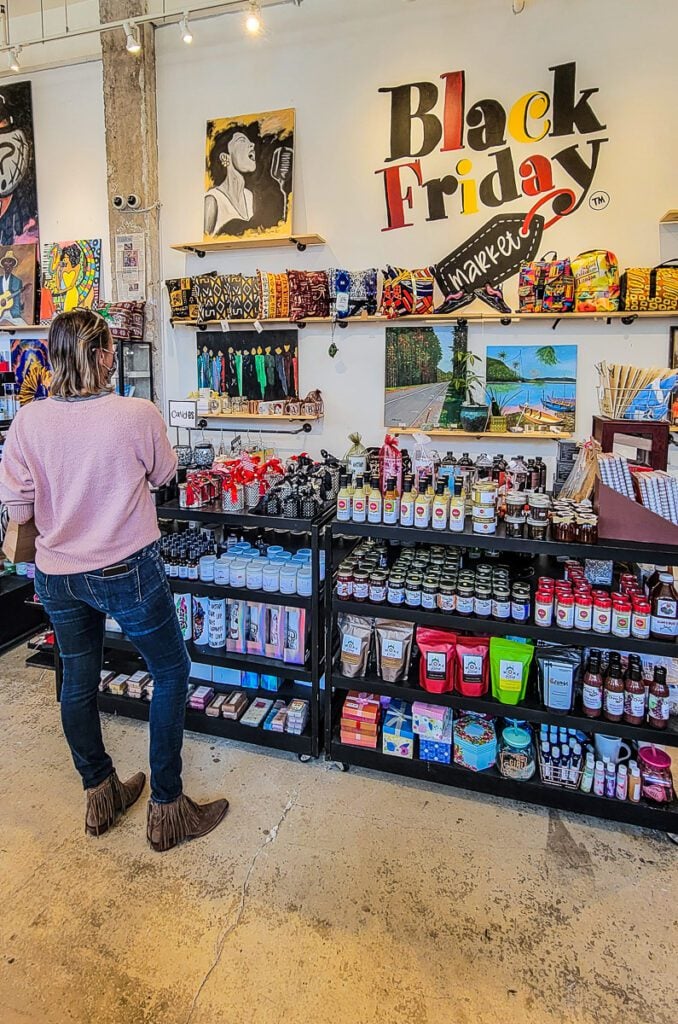
Raleigh is home to a thriving community of Black-owned businesses that contribute significantly to its economic and social fabric.
Supporting black owned businesses is not only a way to promote diversity and inclusion but also an opportunity to invest in the local community and foster economic empowerment.
We’ve curated a list of some outstanding Black-owned businesses in Raleigh across various industries. Make an effort to support them, not just this month, but year-round and help y’all in Raleigh thrive.
Black History in Durham
Durham, North Carolina, is a stop on the Civil Rights Trail, not only for its role in the sit-in movement and inspiring nonviolent protests throughout the Jim Crow South, but also for its rich Black heritage, community, and entrepreneurial spirit that helped build the Bull City.
Black Wall Street
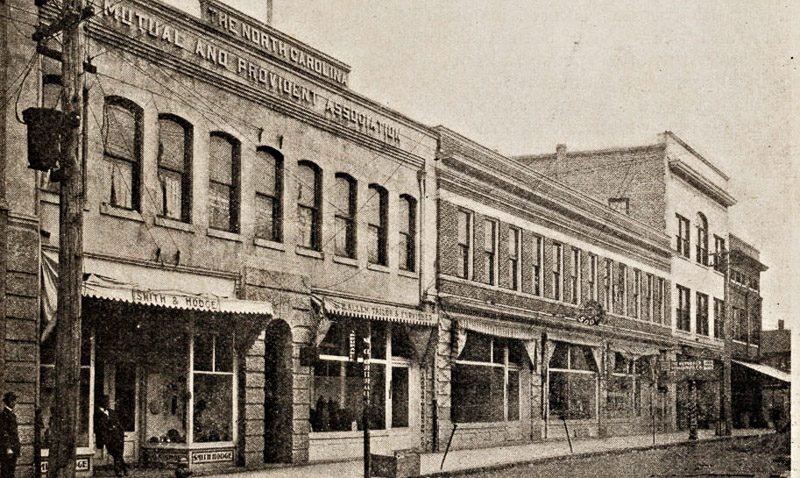
Black Wall Street, as West Parrish Street became known as in downtown Durham, was a hub for black-owned businesses that thrived during the early 1900s.
The very first African American bank and second-oldest minority-owned bank in the United States (Mechanics and Farmers Bank) was founded here, as well the North Carolina Mutual Life Insurance, the largest and oldest Black life insurance company.
Black Bull City entrepreneurs are continuing to thrive in this diverse city. Some downtown businesses to check out include Jeddash’ Tea, Zen Succulents, and Beyu Cafe.
Discover Durham has a Black History Guide that showcases 33 places in Durham related to black history. You’ll find many plaques and murals across the city sharing the Black history story.
Read our post on things to do in Durham in 48 hours
Hayti Heritage Center
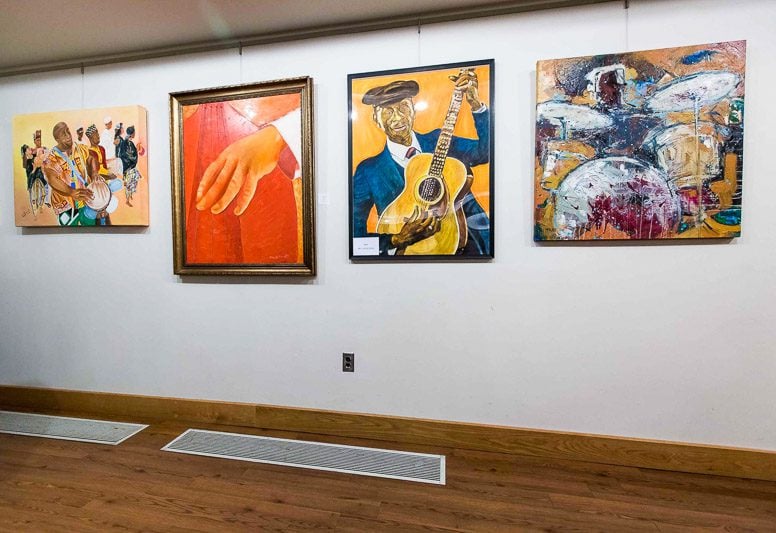
The educational Hayti Heritage Center, located in the former St. Joseph’s AME Church, is a National Historic Landmark. The church itself has its origins with a makeshift ‘Brush Arbor” shack for worshiping. It was built in 1868 by Edian Markham, an African American Methodist Episcopal Missionary and former slave.
The original structure of St. Joseph’s AME Church was constructed in 1891 through the efforts of a proud and determined African American congregation and the support of local white philanthropists. It has long symbolized the dignity and resolve of a people in what was once known as the most prosperous African American community in the United States.
The Hayti Heritage Center opened its doors here in 1975 and is dedicated to cultural enrichment and understanding, offering a variety of diverse events, activities and programs that preserve and embrace African American heritage.
Historic Stagville, Durham
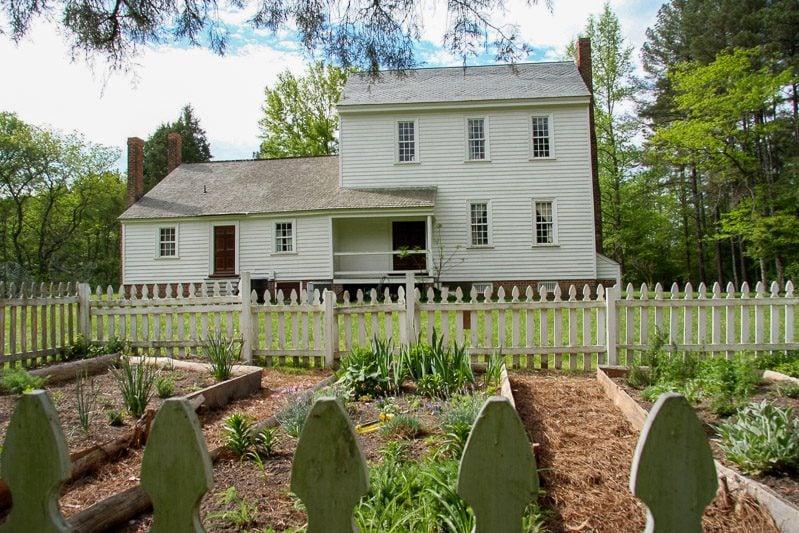
- Address: 5828 Old Oxford Highway Durham, N.C. 27712
- Hours: Tuesday – Saturday 9 a.m. – 5 p.m.
- Cost: Free. Guided tours are $2 adults, $1 kids
Historic Stagville is a state historic site that includes the remnants of one of the largest plantations in North Carolina. The Bennehan-Cameron family owned approximately 30,000 acres of land and claimed ownership over about 900 people who were enslaved on this property.
Stagville protects a fraction of the land from that plantation, including original slave quarters (1851), a massive barn (1860), and a Bennehan family house (1787-1799). Stagville is dedicated to teaching about the lives and work of enslaved people on the plantation.
The Nasher Museum of Art
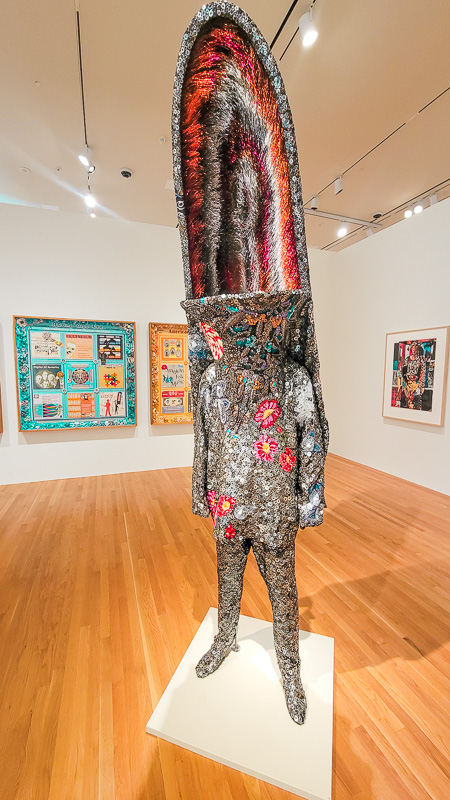
The Nasher Museum of Art is located at Duke University and is the biggest center for arts in Durham. The space opened in 2005 and has been dedicated to showing contemporary art, as well as works from artists they feel have been underrepresented historically.
There is a particular focus on artists of African descent, as well as some European medieval art and ancient American art.
- Hours: 10.00am – 5.00pm Tuesday – Wednesday, 10.00pm – 9.00pm Thursday, 10.00am – 5.00pm Saturday, 12.00mp – 5.00pm Sunday, Closed Monday
- Address: 2001 Campus Drive Durham, NC 27705
Are there any other Black American attractions, places, events, or Black-Owned businesses we’ve missed that you’d like to recommend? Please share in the comments.
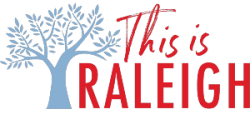
Thank you so much for sharing this! I learned a lot myself. I love your blog—thanks for everything you do.
Glad you enjoyed it Eddie.
This site was really wonderful. I publish 3 newsletters a month and would like to use some of this material. Is that possble. I loved the story on St Agnes Hospital. I w0uld ove for you to submit a column with pictures of the different things you have written about Raleigh. My phone number is 919-772-5472 J. C. Knowles – Thanks